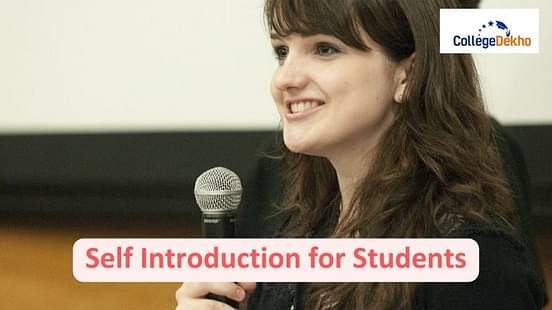Mastering student self introductions requires attention to detail and effective communication, emphasizing clarity, uniqueness, relevance, and adaptability. It fosters meaningful connections with classmates or teachers and leaves lasting impressions.

Self introduction for students is an opportunity to introduce themselves in a professional or social setting. The saying "First impression is the last impression" holds immense significance, especially when delivering a self-introduction for an academic interview or college placement. When you introduce yourself, you have a golden opportunity to make a lasting impact. A well-crafted self-introduction not only communicates key information but also showcases personality traits and passions.
Mastering student self introductions is important and involves paying close attention to details and understanding effective communication. Clear speaking, highlighting unique qualities, relevance, and adaptability are crucial. With the tips discussed below, you can create self-introductions that go beyond just being formalities, making a lasting impression.
Also Read: Top Institutes with 100% Job Placements in 2023
5 Tips for Self Introduction for Students
Crafting a compelling student self introduction may appear simple, but without proper guidance, it can convey a less-than-ideal impression. Consider the following tips to master the art:
Craft an Outline of Your Introduction
When preparing for the introductory session, students should start by creating a rough outline of the key points they want to cover. A student self introduction should kick off with a warm greeting, followed by sharing personal details such as their name, place of origin, and educational background. This can be followed by discussing their aspirations and interests. They can conclude with an engaging call to action or an interesting closing remark to wrap up the introduction.
Keep a Positive Body Language
Maintaining positive and open body language is essential for making a lasting impression when introducing yourself to others. It is recommended to greet others with a warm and genuine smile, as it is often seen as a gesture of appreciation. A confident and optimistic attitude can go a long way in creating a favourable impression, even if there are minor flaws or mistakes in the introduction.
Talk Passionately About Your Interests
Students should provide a concise yet captivating overview of their unique talents, interests, aspirations, and future objectives when introducing themselves. During a self-introduction for students, discussing hobbies or passions can offer the audience valuable insights into one's character. For instance, when participating in an interview for advanced studies, share details about the most recent book you've read and explain how it has influenced you.
Share Your Struggles and Achievements
A student self introduction that candidly discusses the challenges you have faced and how you managed to overcome them without losing confidence has the power to resonate with others. Sharing your academic achievements, which reflect your dedication and hard work, can offer a glimpse into your character and values. So, don’t hesitate to talk about the obstacles you encountered in life and how you overcame them.
Keep the Context in Mind
When crafting or delivering your self-introduction speech, it's crucial to consider the specific context of the event or situation. For instance, if you're introducing yourself in a professional or academic setting, it's important to tailor your introduction to align with the goals and values of the organization or institution you're addressing. This could involve highlighting how your personal goals and aspirations are in harmony with the mission and objectives of the university or institute.
Importance of a Powerful Student Self Introduction
A self-introduction serves as the first step in establishing new connections, which can lead to new opportunities. It can help students feel more at ease, build rapport, and form friendships with their peers and teachers. It's best to keep your self-introduction brief yet engaging to make a strong impression. Here are some advantages of creating a compelling self introduction for students:
- Creating the Right First Impression: Self-introductions give people your first impression and at times it often forms the basis of how people treat you. If your introduction impresses the tutors, interviewers, or any other target audience, it will open doors to academic success.
- Generating Curiosity: Crafting a compelling student self introduction involves skillfully showcasing various facets of one's personality and conveying a sense of ambition. When executed successfully, such an introduction piques the interest of the intended audience, leaving them curious to learn more.
- Conveying Skills and Unique Qualities: Highlighting your unique and best qualities is what makes your introduction powerful. Students willing to make themselves a centre of attraction can utilize this opportunity to detail their strengths and special qualities.
- Building Rapport and Forming Friendships: An engaging self introduction for students can break the ice and help you build rapport with peers and teachers. By sharing experiences and interests that people can relate to, you can build connections and friendships. This can help create lasting and supportive relationships.
- Facilitating Academic and Professional Opportunities: A strong self introduction can open doors to academic and professional opportunities. By clearly expressing your goals, interests, and qualifications, you show that you are proactive and motivated, making a positive impact in academic pursuits.
Things to Avoid During Self Introduction for Students
To make your introduction engaging and effective, try avoiding the following bad practices.
- Don’t Be Overly Informal: No matter how confident and comfortable you may feel, it's suggested not to use causal or informal language. Self-introduction should be devoid of any slang or informal tone.
- Keep it Concise: While it's tempting to delve into every detail of your life, keep your introduction brief and focused. Highlight key aspects of your background, interests, and achievements without overwhelming your audience with unnecessary information.
- Keep a Check on Your Tone: Pay attention to the tone of your introduction, striking a balance between confidence and humility. Avoid coming across as boastful or arrogant by focusing on your strengths and accomplishments modestly and respectfully.
- Don’t Overshare Personal Information: In the quest to sound cool and confident, try not to overshare your personal information. The student's self-introduction should be relevant, short, and aligned to the context of the event.
- Stay Relevant: Make sure that your introduction stays relevant to the context of the event or setting. Tailor your content to suit the audience and purpose of the occasion, avoiding unrelated information that may distract them from your main message.
Crafting a compelling self-introduction as a student is a fundamental skill that can greatly enhance your ability to connect with others and make a memorable impression. We believe the tips on self introduction for students will help you prepare your introduction effectively which will grab the target audience’s attention. All the best!
For information related to courses, colleges, or related topics, keep browsing our articles. If you have any queries, feel free to drop our questions in the CollegeDekho Q&A section.Quick Links:
| How to Start, Lead and Conclude a Group Discussion (GD)? | How to Become a Topper |
|---|---|
| How to Prepare for Your Business School Interview? | Top Private Education Colleges in India 2024 |

















Similar Articles
Police Ranks in India: Police Posts with Badges
Documents Required for EWS Certificate
List of Animation Courses After 12th: Details, Fees, Scope, Jobs & Salary
SSC CHSL Application Form Correction 2024: Check Dates, Process, Details to Edit
List of Documents Required for SSC CHSL Application Form 2024: Image Uploading Process, Specifications
CTET Paper 2 2024: Check Weightage, Type of Questions and Preparation Tips